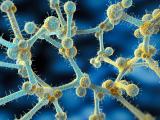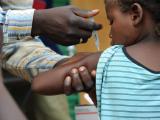Oct 16, 2012 (CIDRAP News) – Nineteen more patients have been sickened in a fungal meningitis outbreak linked to contaminated steroid injections, and a federal official today urged clinicians to contact patients who received other drugs made by the company involved, in view of worrisome investigative findings.
The US Centers for Disease Control and Prevention (CDC) said in an update today that the illness total has risen to 233, an increase of 19 since yesterday. No new deaths were reported, keeping the total at 15, and the number of affected states also remained at 15.
Two of the cases are peripheral joint infections, and the rest are fungal meningitis. The patients are among about 13,000 people who received injections from three recalled lots of methylprednisolone acetate, steroids that were used to treat back pain and joint pain.
New England Compounding Center (NECC) in Framingham, Mass., the maker of the drugs, has recalled all of its products. Janet Woodcock, MD, who directs the Food and Drug Administration (FDA) Center for Drug Evaluation and Research, told clinicians that though no infections have been definitively linked to the company's other products, the FDA can't assure the safety of those products, given conditions officials observed at the plant and other factors that surfaced during the investigation.
Yesterday the FDA announced that it was investigating three patients with suspected infections who were treated with other NECC products. Today the FDA narrowed the number of suspected infections to two.
One case involves a heart transplant patient who had an Aspergillus fumigatus infection after receiving an NECC-made cardioplegia solution. The other patient had symptoms of fungal meningitis after receiving an epidural injection with the company's triamcinolone acetonide, another type of injectable steroid.
Though the patients' infections haven't been linked to NECC, Woodcock said the FDA is concerned enough to ask clinics to follow up with patients who received the company's other products, which include drugs used during eye surgery. "We are asking clinics to actively contact patients to make sure that they're well and don't have symptoms of infection," she said.
Tom Chiller, MD, MPH, a medical epidemiologist with the CDC's National Center for Emerging and Zoonotic Infectious Diseases, told clinicians that both of the peripheral joint infections identified in the outbreak involved ankles. Though fungus hasn't been confirmed in the patients' fluids or cultures, physicians have ruled out other causes of infection. He added that fungi can be difficult to detect in clinical samples, especially if they are invasive types.
In another development, a third type of mold—Cladosporium—has been detected in one of the patients sickened in the outbreak, Chiller said. However, most of the cases have involved Exserohilum, a type of black mold that has never been known to cause fungal meningitis before, which has complicated the diagnostic testing and treatment picture for clinicians. He said treatment guidance for Cladosporium is similar to that for Exserohilum.
Over the last few days the CDC has updated some of its guidance for clinicians, Chiller said. The main highlight is that the recommendation for empiric treatment of mild or moderate infections has changed from a two-drug regimen to just voriconazole for initial treatment, Chiller said. If patients' symptoms worsen on voriconazole, physicians should add liposomal amphotericin B.
Also, for diagnostic testing, the CDC no longer recommends Aspergillus galactomannan testing, since most of the infections involve Exserohilum.
Yesterday the CDC issued interim treatment guidance for joint infections linked to the outbreak, and Chiller said today that the agency expects to release diagnostic guidelines tomorrow for joint infections.
See also:
Oct 16 CDC fungal meningitis outbreak update
Oct 16 CDC COCA call information



















